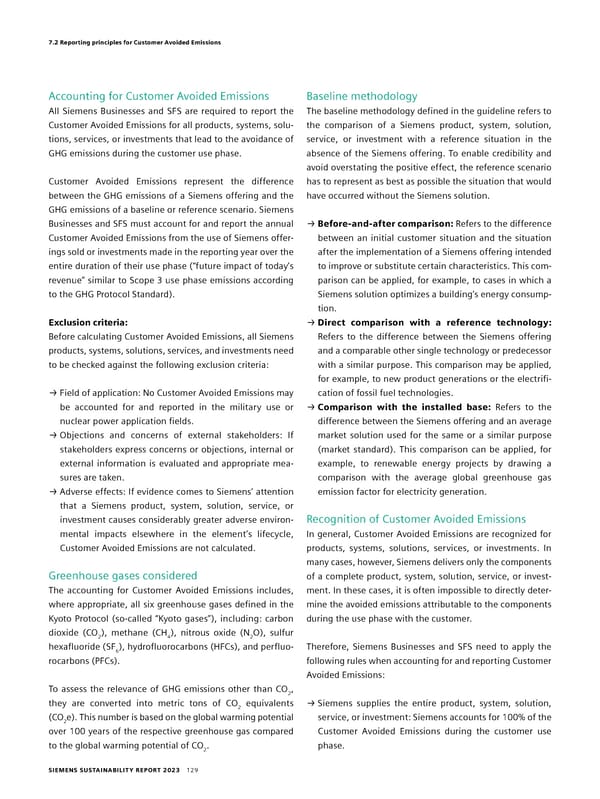7.2 Reporting principles for Customer Avoided Emissions Accounting for Customer Avoided Emissions Baseline methodology All Siemens Businesses and SFS are required to report the The baseline methodology defined in the guideline refers to Customer Avoided Emissions for all products, systems, solu- the comparison of a Siemens product, system, solution, tions, services, or investments that lead to the avoidance of service, or investment with a reference situation in the GHG emissions during the customer use phase. absence of the Siemens offering. To enable credibility and avoid overstating the positive effect, the reference scenario Customer Avoided Emissions represent the difference has to represent as best as possible the situation that would between the GHG emissions of a Siemens offering and the have occurred without the Siemens solution. GHG emissions of a baseline or reference scenario. Siemens Businesses and SFS must account for and report the annual → Beforeandafter comparison: Refers to the difference Customer Avoided Emissions from the use of Siemens offer- between an initial customer situation and the situation ings sold or investments made in the reporting year over the after the implementation of a Siemens offering intended entire duration of their use phase (“future impact of today’s to improve or substitute certain characteristics. This com- revenue” similar to Scope 3 use phase emissions according parison can be applied, for example, to cases in which a to the GHG Protocol Standard). Siemens solution optimizes a building’s energy consump- tion. Exclusion criteria: → Direct comparison with a reference technology: Before calculating Customer Avoided Emissions, all Siemens Refers to the difference between the Siemens offering products, systems, solutions, services, and investments need and a comparable other single technology or predecessor to be checked against the following exclusion criteria: with a similar purpose. This comparison may be applied, for example, to new product generations or the electrifi- → Field of application: No Customer Avoided Emissions may cation of fossil fuel technologies. be accounted for and reported in the military use or → Comparison with the installed base: Refers to the nuclear power application fields. difference between the Siemens offering and an average → Objections and concerns of external stakeholders: If market solution used for the same or a similar purpose stakeholders express concerns or objections, internal or (market standard). This comparison can be applied, for - external information is evaluated and appropriate mea example, to renewable energy projects by drawing a sures are taken. comparison with the average global greenhouse gas → Adverse effects: If evidence comes to Siemens’ attention emission factor for electricity generation. that a Siemens product, system, solution, service, or investment causes considerably greater adverse environ- Recognition of Customer Avoided Emissions mental impacts elsewhere in the element’s lifecycle, In general, Customer Avoided Emissions are recognized for Customer Avoided Emissions are not calculated. products, systems, solutions, services, or investments. In many cases, however, Siemens delivers only the components Greenhouse gases considered of a complete product, system, solution, service, or invest- The accounting for Customer Avoided Emissions includes, ment. In these cases, it is often impossible to directly deter- where appropriate, all six greenhouse gases defined in the mine the avoided emissions attributable to the components Kyoto Protocol (so-called “Kyoto gases”), including: carbon during the use phase with the customer. dioxide (CO2), methane (CH4), nitrous oxide (N2O), sulfur hexafluoride (SF ), hydrofluorocarbons (HFCs), and perfluo- Therefore, Siemens Businesses and SFS need to apply the 6 rocarbons (PFCs). following rules when accounting for and reporting Customer Avoided Emissions: To assess the relevance of GHG emissions other than CO2, they are converted into metric tons of CO equivalents → Siemens supplies the entire product, system, solution, 2 (CO2e). This number is based on the global warming potential service, or investment: Siemens accounts for 100% of the over 100 years of the respective greenhouse gas compared Customer Avoided Emissions during the customer use to the global warming potential of CO . phase. 2 SIEMENS SUSTAINABILITY REPORT 2023 129
 Sustainability Report Page 128 Page 130
Sustainability Report Page 128 Page 130